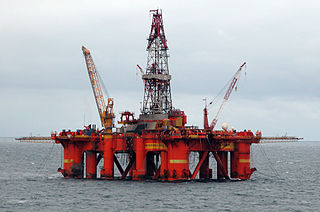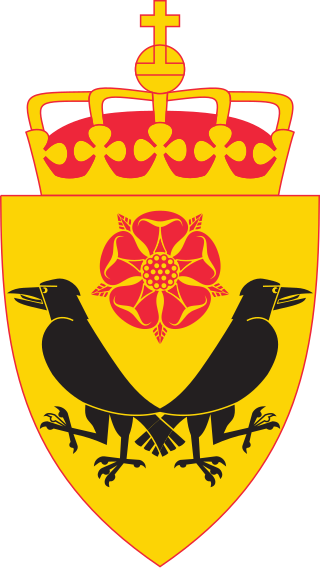
Dynamic positioning (DP) is a computer-controlled system to automatically maintain a vessel's position and heading by using its own propellers and thrusters. Position reference sensors, combined with wind sensors, motion sensors and gyrocompasses, provide information to the computer pertaining to the vessel's position and the magnitude and direction of environmental forces affecting its position. Examples of vessel types that employ DP include ships and semi-submersible mobile offshore drilling units (MODU), oceanographic research vessels, cable layer ships and cruise ships.

An icebreaker is a special-purpose ship or boat designed to move and navigate through ice-covered waters, and provide safe waterways for other boats and ships. Although the term usually refers to ice-breaking ships, it may also refer to smaller vessels, such as the icebreaking boats that were once used on the canals of the United Kingdom.

A semi-submersible platform is a specialised marine vessel used in offshore roles including as offshore drilling rigs, safety vessels, oil production platforms, and heavy lift cranes. They have good ship stability and seakeeping, better than drillships.

ISTAR stands for intelligence, surveillance, target acquisition, and reconnaissance. In its macroscopic sense, ISTAR is a practice that links several battlefield functions together to assist a combat force in employing its sensors and managing the information they gather.

The Northrop Grumman MQ-4C Triton is an American high-altitude long endurance unmanned aerial vehicle (UAV) developed for and flown by the United States Navy and Royal Australian Air Force as a surveillance aircraft. Together with its associated ground control station, it is an unmanned aircraft system (UAS). Developed under the Broad Area Maritime Surveillance (BAMS) program, the Triton is intended to provide real-time intelligence, surveillance and reconnaissance missions (ISR) over vast ocean and coastal regions, continuous maritime surveillance, conduct search and rescue missions, and to complement the Boeing P-8 Poseidon maritime patrol aircraft.

A deep-submergence vehicle (DSV) is a deep-diving crewed submersible that is self-propelled. Several navies operate vehicles that can be accurately described as DSVs. DSVs are commonly divided into two types: research DSVs, which are used for exploration and surveying, and DSRVs, which are intended to be used for rescuing the crew of a sunken navy submarine, clandestine (espionage) missions, or both. DSRVs are equipped with docking chambers to allow personnel ingress and egress via a manhole.

Sea Shadow (IX-529) was an experimental stealth ship built by Lockheed for the United States Navy to determine how a low radar profile might be achieved and to test high-stability hull configurations that have been used in oceanographic ships.

A research vessel is a ship or boat designed, modified, or equipped to carry out research at sea. Research vessels carry out a number of roles. Some of these roles can be combined into a single vessel but others require a dedicated vessel. Due to the demanding nature of the work, research vessels may be constructed around an icebreaker hull, allowing them to operate in polar waters.

The Russian nuclear submarine K-141 Kursk sank in an accident on 12 August 2000 in the Barents Sea, with the loss of all 118 personnel on board. The submarine, which was of the Project 949A-class, was taking part in the first major Russian naval exercise in more than 10 years. The crews of nearby ships felt an initial explosion and a second, much larger explosion, but the Russian Navy did not realise that an accident had occurred and did not initiate a search for the vessel for over six hours. The submarine's emergency rescue buoy had been intentionally disabled during an earlier mission and it took more than 16 hours to locate the submarine, which rested on the ocean floor at a depth of 108 metres (354 ft).

Technical research ships were used by the United States Navy during the 1960s to gather intelligence by monitoring, recording and analyzing wireless electronic communications of nations in various parts of the world. At the time these ships were active, the mission of the ships was covert and discussion of the true mission was prohibited. The mission of the ships was publicly given as conducting research into atmospheric and communications phenomena. Their designation was AGTR – Auxiliary, General, Technical Research – but it was more or less an open secret that this was a euphemism and they were commonly referred to as "spy ships".

A spy ship or reconnaissance vessel is a dedicated ship intended to gather intelligence, usually by means of sophisticated electronic eavesdropping. In a wider sense, any ship intended to gather information could be considered a spy ship.

Marine salvage is the process of recovering a ship and its cargo after a shipwreck or other maritime casualty. Salvage may encompass towing, lifting a vessel, or effecting repairs to a ship. Salvors are normally paid for their efforts. However, protecting the coastal environment from oil spillages or other contaminants from a modern ship can also be a motivator, as oil, cargo, and other pollutants can easily leak from a wreck and in these instances, governments or authorities may organise the salvage.

The Norwegian Intelligence Service (NIS) or Etterretningstjenesten is a Norwegian military intelligence agency under the Chief of Defence and the Ministry of Defence.

The draft or draught of a ship is a determined depth of the vessel below the waterline, measured vertically to its hull's lowest—its propellers, or keel, or other reference point. Draft varies according to the loaded condition of the ship. A deeper draft means the ship will have greater vertical depth below the waterline. Draft is used in under keel clearance calculations, where the draft is calculated with the available depth of water to ensure the ship can navigate safely, without grounding. Navigators can determine their draught by calculation or by visual observation.
Signals intelligence by alliances, nations and industries comprises signals intelligence (SIGINT) gathering activities by national and non-national entities; these entities are commonly responsible for communications security (COMSEC) as well.

Salvage diving is the diving work associated with the recovery of all or part of ships, their cargoes, aircraft, and other vehicles and structures which have sunk or fallen into water. In the case of ships it may also refer to repair work done to make an abandoned or distressed but still floating vessel more suitable for towing or propulsion under its own power. The recreational/technical activity known as wreck diving is generally not considered salvage work, though some recovery of artifacts may be done by recreational divers.

The Primor'ye class are a group of spy ships built for the Soviet Navy. Two ships are operated by the Russian Navy. The Soviet designation was Project 394B.

The Vishnya class, Soviet designation Project 864, are a group of intelligence collection ships built for the Soviet Navy in the 1980s. The ships continue in service with the Russian Navy. The Russian Navy operates seven of these ships.

FS Marjata is a Norwegian purpose-built electronic intelligence collection vessel (ELINT), which was ordered by the parliament in 2010. It was baptized on 6 December 2014 by Prime Minister Erna Solberg. The ship is crewed by the Norwegian Intelligence Service.
The Multi-Role Ocean Surveillance Ship (MROSS) is a type of research and surveillance ship in development since 2021 for the United Kingdom's Royal Fleet Auxiliary. The first ship, RFA Proteus, is a commercial ship converted to the role which entered service in October 2023. The second ship is planned, potentially as a new build vessel. Both ships are to be used by the RFA to research and protect critical undersea national infrastructure, such as undersea cables and gas pipelines, in both British and international waters.


















